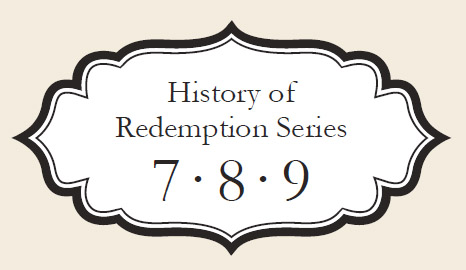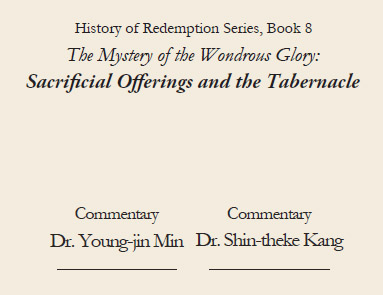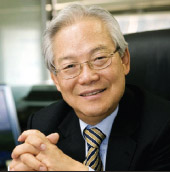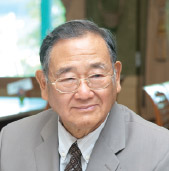|
Commentaries for The Mystery of the Wondrous Glory: Sacrificial Offerings and the Tabernacle (Book 8)
|
|
|
글쓴이 :
관리자
|
|


A praiseworthy achievement for the church of Korea that is not to be found in any other literature in the world

Dr. Young-jin Min
Hebrew University of Jerusalem, Israel, Doctor of Philosophy (Ph. D)
Former professor at The Methodist Theological University
Former head of general affairs at The Korean Bible Society
Chairman of the board of directors, Asia-Pacific region, The United Bible Societies
Distinguished Professor at Korea Baptist Theological University/Seminary
The Christian literature Society of Korea 100th year anniversary Catena- author of commentaries on the books of Exodus, Proverbs, Song of Songs, Judges, Ruth
This book expounds mainly on the book of Exodus within the Bible under the theme of the “5 regulations of the sacrifices and the tabernacle.” The author, who is Christian and not Jewish, thoroughly understands various theological traditions of Judaism in their essence and renders Christological reinterpretations of them.
Rev. Abraham Park’s reinterpretation is executed in a unique redemptive-historical methodology, which hasn’t been attempted by many scholars in the world.
The author reads the Hebrew Bible more thoroughly than the Jewish people. This stems from his exceptional spirituality resulting from his dedication to prayer and reading the Bible over 1,800 times. The author’s work based on the two spiritual powers?prayer and the Word?is beyond being an academic, theological literature; it has a mysterious, enigmatic spell that grips readers to focus only on Jesus Christ on every page.
When he delves into a certain theme, he is more rigorous than the commentators of medieval Judaism.
The level of the author’s commentary work supersedes that of the Midrash, an interpretation of biblical texts in Judaism that often deviates from textual commentary and diverts into mysticism. His redemptive-historical research on the Old Testament reaches its peak at the “five major sacrificial offerings of the Old Testament”
and “the Tabernacle.” His research on the Old Testament is so meticulous and profound that even Jewish people will marvel. Furthermore, it is a new dimensional research that breaks from Judaism and goes beyond it.
1. Regulations of the Sacrifices
Following the introduction in chapter one, the author discusses the regulations of the sacrifices in chapter two. Common books on sacrifices generally cover only the five sacrifices, but the author explains the five sacrifices by classifying them according their purpose (burnt offering, grain offering, peace offering, sin offering, and guilt offering) and by classifying the four offering methods (offering by fire, drink offering, heave offering and wave offering). The author persistently adheres to the methodologies that can render the best understanding of the biblical text. Through his meticulous analysis of the original text, he unravels the original meanings of each sacrificial offering, especially by scrutinizing how the original Hebrew text was translated in the Greek Septuagint. This is one marvelous contribution to the field of biblical studies in our nation.
Among all the books on the subject of sacrifices to this day, this book is unrivaled in its ability to allow the readers to easily understand its contents and vividly capture them in their minds. Most of all, how the author focuses each sacrificial offering onto Jesus Christ to reveal their redemptive-historical significance is truly a Christological exposition of the biblical text.
2. The Ordination and Inauguration of Priests
Chapter three discusses the ordination and inauguration of priests. God established a covenant for the priesthood of Aaron and his sons, and then to make it official, ratified the ordination and inauguration. The
author successfully explains this theme which is unfamiliar even to those who attend church. Specifically, he clearly solves the question of how the Levites, who were cursed by Jacob, could become the priestly tribe by providing a clear biblical answer.
After the death of Aaron’s two sons, Nadab and Abihu, the priestly duties were carried out by the descendants of the two remaining sons, Eleazar and Ithamar. The book also summarizes very clearly how the high priestly duties were carried out by these two lineages and why the Zadokites, descendants of Eleazar, monopolized the high priestly position. This elderly Korean minister has not only organized this book in such way that can be easily read by theologians, ministers, and laymen alike, but he also unraveled the redemptive-historical meanings. I believe that this is the result of the powerful grace of God, mightily working in the churches of Korea.
3. References on the Tabernacle
Chapter four in this book introduces the tabernacle and its exterior structure, and chapter 5 discusses the holy things inside the Tabernacle. Although the tabernacle is a theme that has been dealt with by many scholars to this day, this newly published work is on an entirely different level. The visual references of this book are a great achievement for the biblical society of Korea. The second half of the book of Exodus presents seemingly monotonous, detailed narration on the tabernacle. Unless the reader is a professional, most readers can only absentmindedly skim through this section. Since the narration on the tabernacle construction and its interior structure and managements are very difficult for common readers, and since every scholar proposes different views about the details, people think studying the old-fashioned tabernacle is unnecessary.
But the author instantly silences all of these objections. For the first time in the world, Rev. Park has accu-rately portrayed even the very detailed construction of the tabernacle, all based on the Hebrew language. Furthermore, he suggests a redemptive-historical significance in all of them. Reproductions of “boards connected with bars and gold rings,” “two boards for the corners of the tabernacle at the rear,” “entrance to the court of the tabernacle,” “sockets for the pillars,” “hooks of the pillars,” “fillets of the pillars,” “pegs of the tabernacle,”
and “pegs on the four sides of the court” in Exodus chapter two and three are remarkably elaborate. Although it took me several days just to confirm the descriptions of each of these holy things inside the tabernacle, I was filled with excitement, enjoyment, and gratification. The fact that an elderly pastor has published such an unprecedented, unique, and extensive resource, which cannot be found in any other foreign literature, is a splendid achievement that elevates the church of Korea amongst the churches of the world.
The detailed explanations and approximately 30 or more illustrations together will allow the readers to obtain a clear, vivid visualization of what had been an obscure image acquired through hearsay. The author assists the readers whenever necessary by listing the names of the tabernacle-related things in Hebrew, Greek, Korean, Japanese, and English. Perhaps it could be due to my poor knowledge that I have not yet found in any other literature in the world a similar work on the tabernacle with such detailed descriptions, comprehensive illustrations and accurate explanations based on the original language. But I am certain that this book is, by all means, a source of pride and joy for the church of Korea.
4. The Work of Redemption through the Church
This book finally concludes that the work of redemption unfolds through the church. The author’s thorough research on the Old Testament is an ultimate confirmation of the history of redemption which has begun in Genesis and is completed with the coming of the Son of Man. The explanation of the relationships between the Old and New Testament, between the old covenant and the new covenant, and between the written word and spirit are an open topic for discussion even to this day. In the midst of such a hermeneutical debate, I boldly appraise that Rev. Abraham Park’s The Mystery of the Wondrous Glory: Sacrificial Offerings and the Tabernacle is a wonderful “role-model” in Christian Old Testament research and a masterpiece that demonstrates a new “model” of redemptive-historical interpretation. I sincerely hope that this immense blessing brought forth by this book will not only bless Korea but all churches around the world.
Finally, I express a deep gratitude for the author’s History of Redemption series which has published eight books thus far. This series of books has reached a new plateau as a refreshing and inspiring contribution to the church of Korea and to Old Testament scholarship. From the bottom of my heart, I bless the author’s aspiration to complete the History of Redemption series.

Could not hold back tears while reading
 Dr. Shin-theke Kang Dr. Shin-theke Kang
Hebrew Union College (Ph.D)
Former professor at Yale University and
Trinity Evangelical Divinity School
World renowned expert in Sumerian language
“Hebrew-Korean Study Bible (Old Testament)”
Translator
As I started to read this book, many times I felt tears of great emotion and inspiration fall from my eyes. I wondered, “Such a great man as this exists in Korea! Truly, here is a man who sees tens, hundreds, and thousands by just seeing one!”
The author begins by elaborately explaining the regulation of the sacrifices and the ordination and inauguration of the priests, and as he does, he vividly reveals the image of Jesus Christ embodied therein. The existing books on the sacrifices are usually too simple or too complicated; many of them are too plain or too difficult. But, now, Rev. Park has organized it very clearly while adhering to the profound meanings of the Hebrew text.
Even while handling highly difficult contents that can be understood only by theologians at the doctoral level, he expresses them so plainly that even elementary students can understand. This testifies to the author’s brilliant and genius writing skills.
Until now, if someone said, “This is a flower,” I would know that it was a flower.
However, the author knows the type of flower, the number of petals, and the number of seeds the flower holds. How wonderful is this? The Jewish people have said that the tabernacle was built in the form of a man. However, the author has focused his study on the fact that the true reality of the tabernacle is Jesus Christ, and through each of the vessels within the tabernacle, he reveals the work of Christ in a spectrum of clarity.
So far, I thought that scholars studied a little more in depth and thus knew a little more than others, but it is not so with the author. He does not just know a little more.
He knows deeper, wider, higher, and longer. It is impossible for me not to be amazed.
Using an easy to understand drawing of the tabernacle, the author clearly reveals the misconception scholars have had regarding the structure and shape of the tabernacle.
One minor example may be that he even found out that the word “thickness” in the Korean Revised Version of Exodus 26:23-24 in fact did not exist in the original Hebrew text. Even in drawing all the illustrations of the tabernacle, he drew them according to the original language. This kind of research can only come about from a person who fully believes that the Bible is fully inspired and entirely inerrant Word of God. Moreover, it can only come from someone who is highly proficient in scripture. If such a person did not persistently conduct a tenaciously thorough research, then such an enduring achievement could never have come about.
While translating the “Hebrew-Korean Study Bible (Old Testament),” the most difficult book for me was the book of Exodus. Moreover, the section within the book of Exodus referring to the tabernacle was the most difficult of all. It was a daunting task even for me and I have been studying the Sumerian language my entire life. Then I was so shocked in seeing the research on the tabernacle laid out in the author’s book. He explains in detail with the original Hebrew text the things I wanted to know regarding the tabernacle. Many scholars have already revealed how and with what material the tabernacle was built, but it is difficult to find a book out there that reveals the meaning that each material holds within the perspective of the history of redemption. The newly published The Mystery of the Wondrous Glory: Sacrificial Offerings and the Tabernacle has perfectly depicted the tabernacle and all of the holy vessels contained therein by a thorough exegesis of the Hebrew original text. I feel that the Jewish people must repent of their complacency and study the tabernacle again by reading this book and studying the model drawing. If, through this book, they could see in the tabernacle, Christ and the church which is the body of Christ, how great that would be!
This book meticulously explains the entire process behind the temple construction in three-dimensional details. It gives comprehensive descriptions of the tabernacle’s blueprint, construction period, contributions for the construction, the people in charge of the construction, and the anointing ceremony for its dedication. It further provides elaborate details on the shapes and construction methods of the holy place, the holy of holies, boards and bars, and fence and gates in the tabernacle. The author transforms such complex features into vivid, clear images in the minds of the readers, just as an architect would explain after having completed a building. The author’s such ability is an outstanding feature that distinguishes this book from the others. I can almost visualize the agonizing moments when the author would stay up late struggling to figure out the original form of the tabernacle. This is impossible without a deep understanding of the Bible
and a spiritual insight. It is amazing how this book reveals, through the tabernacle, the kingdom of God to come. It is my earnest hope that this book be translated into many languages and that it would be a part of every seminary library throughout the world.
In conclusion, Rev. Park proclaims that the church, being the body of Jesus Christ, must expand the work of redemption, just as in the time of King Josiah. Just as the Protestant Reformation took place in the 1500s, he hopes that there will soon be a Christian reformation. The Protestant Reformation of the 1500s arose in Europe, but what a great blessing would it be if the next religious reformation rose up from Korea? The U.S.,
which had shared the Gospel with us, should be soaring up like an eagle, but instead the country is falling fast like a crashing plane. It is my hope that in such times as this, the Korean church would become the hope of the world and the driving force behind a global reformation. Every time a book in the History of Redemption series is published, I desire that it would become a hope-filled gift that would achieve such a feat and be proclaimed far and wide. Finally, it is my earnest wish, as a renowned Korean historical theologian once said, that this book would remain in the records of global Christian civilization as a monumentally enduring achievement.

|
|

